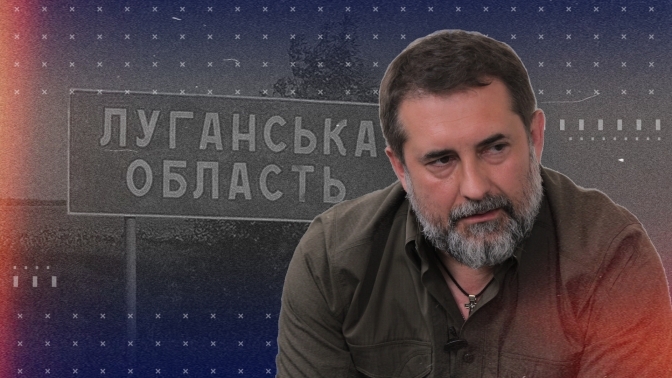
[For urgent updates please follow Ukrainian Freedom News on Telegram]
What is the purpose of your stay in Lviv? Have you already completed some of your tasks here?
My main goal was to bring the leaders of the administrative communities of the Luhansk region and our deputies to the celebration of the National Flag Day and Independence Day of Ukraine. Since 2014, we have established fruitful cooperation and friendly relations with the Lviv Regional State Administration and the Regional Council. Representatives of the Lviv region constantly came to celebrate these days in our city, Severodonetsk. We used to raise the flag together, this happened twice during my term of office [Haidai has been the head of Luhansk Regional State Administration since October 25, 2019, after replacing Vitalii Komarnytskyi in this position]. In 2022, unfortunately, such a celebration was impossible because almost the entire region is occupied. So we decided to go celebrate these days with you. Lviv is my hometown too: I lived here for 16 years, graduated from school, got married, and my daughter still lives and works here. It can be said that I came from my native Luhansk region to my native Lviv.
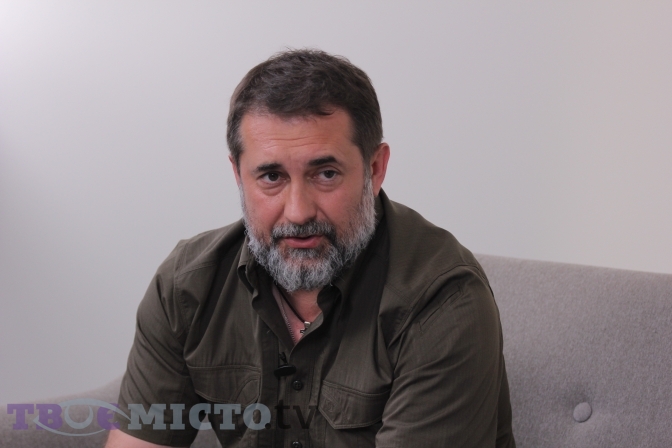
The heads of the military administrations, my deputies and the heads of administrative communities willingly responded to this proposal, got to know everyone, talked with them, and recently opened a humanitarian headquarters in Lviv.
Am I correct that one of the communities oversees this headquarters, but it’s designed for all residents of the Luhansk region?
Right. We say that the Luhansk region is now where Luhansk people are – and they are everywhere. More than 300 000 people were forcibly evacuated from the region and moved around the country. There is no region in Ukraine where evacuated residents of Luhansk Oblast would not be temporarily settled. Therefore, we decided to open humanitarian headquarters in each region. We agreed that we would open one or two headquarters centres in each city, depending on the number of registered internally displaced persons. For example, in Kyiv, we’ll have to arrange far more than a couple of such centres.
In Lviv, the headquarters is under the care of the Starobilsk community of the Luhansk region, but it will serve all residents of the latter, regardless of where they are from – Severodonetsk, Novopskov, or Troitske. Soon it will be launched and become fully operational. During the preparation for the opening, we agreed with the ministry about premises, received all the permit documentation, and even did the branding.
Not only Luhansk residents who have moved here, but also Lviv residents who want to help can apply, cannot they?
Of course, such help will be pretty appropriate now. People have a lot of problems. We can talk about different aspects, starting from some items and ending with humanitarian food sets or kits of the most necessary medicines. We will be grateful for any help! Imagine what it’s like to leave your own home with one suitcase. It cannot be expressed in words. God forbid that none of the Lviv residents ever has such an experience!
Should we expect a new wave of migration to Ukraine’s West before winter? Given your communication with humanitarian headquarters all over Ukraine, can this happen and what do we need to prepare for?
Most likely, there won’t be mass migration. Exactly half a year has passed since the start of the full-scale offensive and evacuation. Under our control, with the help of the National Police, volunteers, and the military, 50,000 people were evacuated. All administrative communities worked on this. Chiefly, they’ve already found a roof over their heads.
However, for the most part, this evacuation lasted at the end of the academic year, when no full-time education took place due to the war. So people were resettled in schools and dormitories of educational institutions. From September 1, probably, some educational institutions will start working, and accordingly, the dormitories will have to be vacated. Given this, we are now collecting housing stock for evacuees in all regions.
That is, those who have some suggestions can contact you either through the «Prykhystok» (Shelter) government program or through the headquarters, right?
Yes. In Lviv, the humanitarian headquarters was located in the building of the Lviv Prosthetic Plant (Rudnytska Street, 10). It’s easy to find as the entrance is directly opposite the bus stop. And a huge banner with information about the headquarters immediately catches the eye.
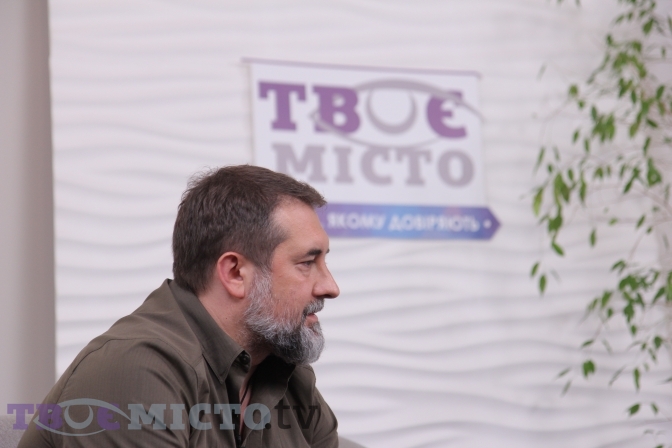
How did February 24 start for you?
The day before, we already understood that something had to happen, as we have a common border with the Russian Federation. A few weeks earlier, Russia brought up equipment, several dozen tanks, like it was in 1941. We were once told that at that time, Nazi Germany approached the borders of the Union, gathered tanks, and the Nazis drove up and left, provoking the other side with their behaviour. It was the same with us.
The Russians placed tanks three kilometres from the border. Every day they were started, roared, or drove 100-200 meters and stopped. We saw them send out so-called «secrets», pairs of soldiers in the woods along the border, and understood that something had to happen [a «secret» is an additional camouflaged sentry post of several people, which is placed on the most dangerous approaches from the enemy, to prevent his undetected advance and an unexpected attack; the term also defines the location of such a post]. On February 24, the head of the border service of the Luhansk region called me and said that our border guards were shot dead, the Russian equipment has already moved across the border. Calls began to arrive about shelling and explosions all over Ukraine. I contacted the President’s Office, and we talked. After gathering in our office, we opened secret packages and began to act according to the instructions. And already in the morning, the shots of «Calibers» began, the first one in the area of the Severodonetsk airport.
During the last six months, you say that it was impossible to hold the Luhansk region, in particular, due to the lack of adequate weapons that would allow stopping the offensive. How do you explain the lack of necessary weapons, especially in the border areas?
If we talk about the necessary weapons, then we mean the Western ones, which we began to receive after February 24. And even later, because this did not happen in the first days and weeks. Our still Soviet weapons wouldn’t have helped much, because they gave the opportunity to only partially restrain the enemy, not to stop or repulse him in order to launch a counterattack. After all, a country with 140 million inhabitants is fighting against us, which inherited a lot of Soviet weapons from the Soviet Union. So while we have thousands of shells, they have millions of them. Everything from Soviet warehouses is there.
Let’s recall what has been happening in Ukraine since 2014 – explosions of warehouses with ammunition. These were one hundred per cent terrorist acts of Russia. Even here, in Svatove, a warehouse with a huge number of shells was blown up.
On the battlefield, Russian soldiers are not something special. Why then do they advance, you may ask. It’s because Russia has a lot of military, equipment and mere unlimited shelling. Within an hour, there were 186 «arrivals» at one of our positions, and only 12-14 in response from us. And the shells were also constantly delivered to them.
Now let’s see how the situation has changed in four months. During this time, we were destined to become an outpost of entire Ukraine under the most difficult conditions. Thank God that when the Russian army marched towards Kyiv, Sumy, and Chernihiv, someone misled them into thinking that we would meet them with bread, tricolours, and photos of Putin. Nothing of the sort happened, and Ukraine began to resist not only at the level of the armed forces. Everyone joined: the National Guard, border guards, and ordinary citizens, civilians, many of whom joined the territorial defense. The Russians entered «relaxed», the military call it «on the armour»: a parade-formation march, with insufficient ammunition and fuel to advance further. So when the Ukrainians began to resist, they were, to put it mildly, surprised. Perhaps, that is why the atrocities took place in Irpin and Bucha because they did not expect that they would also be killed.
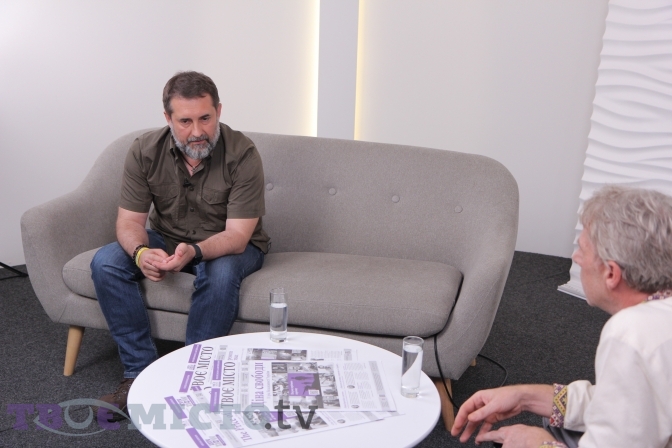
As for the Luhansk region, the Russians had no illusions there. When they entered our territory together with the «Kadyrovtsy», «DNR» and «LNR» soldiers, they clearly understood that they would be met here by military units that would fight with them. The only thing was that we did not have enough weapons.
Warehouses continue to be blown up on the territory of the Luhansk region, but now it happens deep in the rear of the Russian army. Just as Russian command centers and headquarters. Here is a demonstration that the weapon we received works, giving us the advantage and the ability to deter the offensive they were planning. The task of the occupiers is to advance five kilometres per day. And now, they manage to advance a maximum of 800 meters on a case-by-case basis, not even daily. Russians consider it a huge achievement. But they are immediately thrown back and lose their offensive potential. They still keep to the outskirts of the Luhansk region, although there is not a large area left there [under Ukraine’s control].
I often think about the information field in which Ukraine, residents of the occupied territories, and Russians near the border used to live. Did the situation change after the channels, supposed to re-agitate people and convey the truth, started working?
The information war is the only one in which we have completely lost. At the beginning of the term, I drove a car through the settlements on the demarcation line and turned on the radio. What I heard was only the ones like «Red Star», «Pobyeda», or «Russian Army». Everything of Russian propaganda, I haven’t even heard anything Ukrainian. All television is free «dishes» aimed at the NTV satellite, which caught exclusively Russian TV channels with round-the-clock propaganda. The amount of propaganda that has been pouring into the brains of residents since 2014 is just enormous. When I realized this, I immediately started writing letters to the National Security Council, the government, and ministers personally. I asked to find some opportunity, to finance equipment that would jam Russian channels, and amplify our Ukrainian signal so that it reaches the occupied territory. Unfortunately, none of this was done. The only thing we managed to do was build a fairly powerful TV tower, and it worked.
Do you mean the repeater?
Yes. Thanks to it, Ukrainian radio waves reached the borders with the Russian Federation, and the television signal could be received within a radius of 50 kilometres from the TV tower. But Russia is really «ahead of the whole planet» in propaganda.
Maksym Kozytskyi, governor of the Lviv region, told us in an interview that about eight thousand people suspected of collaborating with the enemy and adjusting the fire had been checked in his area of responsibility. The authorities were looking for agents who have been here for a long time. How did this process take place in the Luhansk region, as the level of suspicion and anxiety is much higher there than in Lviv?
There were few people left in that part of the Luhansk region where the active phase of hostilities was going on. 90 per cent were evacuated. Until February 24, 120 000 people lived in Severodonetsk, now there are 10 000 left, and 15 000 in Lysychansk.
The Security Service of Ukraine (SBU) worked with those who remained and periodically found fire adjusters. Their data were entered into the registers, some of them were arrested. There were different situations, but the guys worked after February 24 and neutralized them. Unfortunately, there were quite a lot among those who remained...
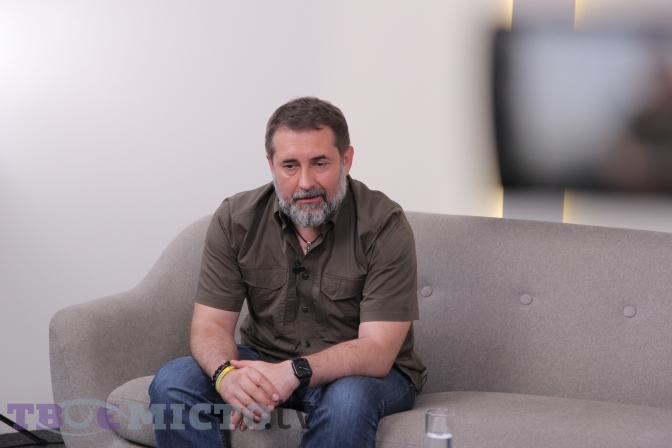
How would you assess the role of the Church in this matter? Especially the Orthodox Church of the Moscow Patriarchate, which claims to be already independent, but maintains its ties with Moscow. How was it in the Luhansk region?
A pity, but we know about cases when, during the inspection of the clergymen of the Moscow Patriarchate, smartphones with the coordinates of our military positions were found. They cooperated with the Russians, with their Security Service (FSB). SBU employees detained several persons, who testified that they not only cooperated with the FSB, but also worked for various divisions of the LNR, leaking information to them about the movements and locations of the Armed Forces.
Were there cases of desertion from the enemy side?
Do you mean the military or civilians? Among others, there are people who help us, I can’t say anything more about it. If I tell what administrative community they are from, I will expose them to mortal danger.
Regarding the military: sometimes someone manages to cross over to our side unscathed. They seem to surrender. Why do I say «sometimes» and «manage»? Because a person who comes from the side of the enemy is an enemy. Our soldiers shoot at them, kill them because their task is to destroy the enemy. Even capturing a person who wants to surrender is not easy: behind those who do not want to fight, there are blocking units – «Kadyrovtsy» or someone else [blocking units are units placed behind the main troops to prevent the escape of military personnel from the battlefield, in order to catch spies, saboteurs and deserters, to return some of the fugitives and servicemen who fell behind]. So if the soldiers go forward, want to surrender, raise their hands, these squads shoot them.
Surrender is possible when a platoon, 20-30 people, goes to attack, is repulsed, and someone manages to stay on the battlefield. This person gives some signals and is taken away. This is how prisoners of war are taken. Such situations have happened to us more than once. And you can also take prisoners after our units rush into populated areas and find «relaxed» militants there. A person can’t just walk over to us because it’s difficult from a security point of view: if I see someone in their uniform coming, I’ll just shoot.
I asked about this to understand if everyone is really that zombified. If we could trace the trend of the increasing number of those who surrendered, it could indicate the level of demoralization in the Russian army.
There are cases when they refuse to fight. Especially now. These are mainly soldiers from units that were formed from newly mobilized ones. They simply miraculously survived five months of continuous offensives in the Luhansk region. Russians have huge losses. As a result of the crossing operation in Bilohorivka only, the battalion lost 500 people and 100 units of heavy equipment. This story will definitely enter the books about our victory in the Russian-Ukrainian war.
The Russian army does not fight at the «front», just like the «Kadyrovtsy». Instead, the recently mobilized are thrown into battle. They come after many hours of shelling to find weak spots in our defenses and find out what the artillery destroyed. Or to identify the firing positions of our military and then «cover» them with artillery. After them, «LNR soldiers» come, whom the Russians treat with the same disdain, they don’t consider them people at all. It happens that the so-called LNR units refuse to fight for the so-called DNR, saying: «We liberated our republic, we fulfilled our duty and we will not go any further.» Because they understand that they are used as cannon fodder.
Currently, the main fighting force of the Russians are units of the «Wagner» private military organisation, because they are mercenaries who do not need to be counted. It does not matter how many of them died – 100 or 500, because they are individuals motivated by money.
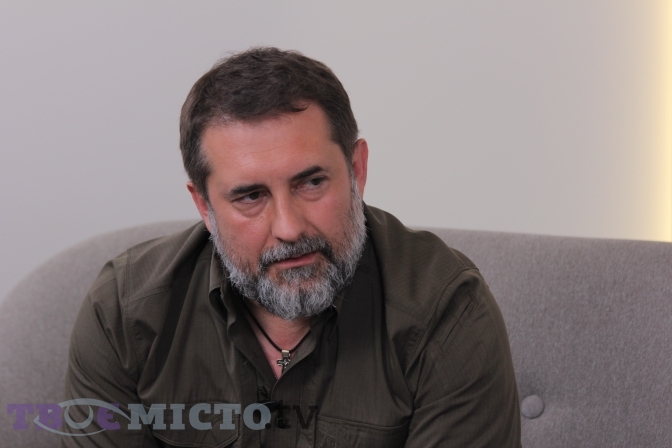
Is it noticeable that Russia’s recruiting initiative has worked, are there mercenaries from other countries?
There’s very few of them, but there will always be someone, as we have seen this since 2014. Now, the «Wagners» have huge losses. Thanks to the recruitment campaign, they replenish their ranks with people who do not know politics, go to fight for money or are supporters of Russian ideology, as well as those who are serving sentences in certain institutions. That is, they recruit the best from the worst and let them go.
If earlier, the «Wagners» were a professional private military company, now they are people who only know how to handle weapons and have served somewhere. Their units are not as coordinated as before.
Earlier you talked about strange calls, of which there were three. Those who called you were sent after the Russian warship. But for them, you can be a target, a person to be intimidated. Do you feel that pressure?
There was no terrible pressure, no threatening text messages, and no crazy number of calls. Well, Russians published information in their media that «Putin’s cook», Prigozhin, had arrived, and together with the «Wagnerians», was tasked with either capturing or eliminating the leaders. There are two of the targets – me in the Luhansk region and Pavlo Kyrylenko, my colleague is in the Donetsk region. And all others who make decisions, because we did not have a body of deputies.
The «Kadyrovtsy» were still excited after my appeal, but that’s it [in early June, Haidai published a video on his Telegram channel in which he addressed Kadyrov and advised him to «count» the fighters after meeting with our military in Severodonetsk].
Do you follow special safety measures?
This is a region where you cannot move without personal guards, because the war here has been going on for years. Even if you drive an armoured minibus that used to be a cash-in-transit vehicle. Until February 24, we did not have armoured vehicles, special transport was allocated to me and my colleague for the 110th day of the war. But it still isn’t a panacea, because it can only protect against bullets and debris, and not even all of them.
I am proud of the fact that no civilians died during the evacuation. But we had a tragic story with a French journalist who, together with the team, filmed the entire evacuation process. At that time, the troops had already withdrawn from Severodonetsk, it was very dangerous in Lysychansk, it was shelled a lot. It was from there that people were taken out, they had to be transported in an armoured truck provided by a people’s deputy from the Luhansk Region. During one of the trips to pick up people, just when the journalists were in the car, there was an «arrival» of a shell. Not in the truck, but in front of it. One of the fragments pierced the armoured glass and mortally wounded the journalist in the neck. He was not saved by an armoured car, a bulletproof vest, and a helmet. So there is no panacea.
You use the phrase «the so-called LNR». How would it be named in the right way? It’s said that the correct calling would be «occupied areas of the Luhansk region». How do you think these areas should be called?
I say «the so-called LNR, DNR» because they call themselves like that. If we are talking about their units, then it is better to identify them precisely as units of the so-called LNR purely in order to define combat units. Because if we call it our own way, confusion will begin in understanding who exactly went on the offensive or lost ground.
In the Luhansk region, in more or less peaceful times, until February 24, we hardly said «the LNR is over there.» For us, calling this territory «LNR» is tantamount to recognizing the Luhansk People’s Republic. Therefore, for everyone, it is ORDLO [separate districts of the Donetsk and Luhansk regions] or quasi-republics. We use LNR and DNR only with the words «so-called» and only if it refers to combat units.
Sergiy Smirnov spoke
Text: Marichka Ilyina, translated by Vitalii Holich
Photo: Dmytro Taradayka
Full or partial republication of the text without the written consent of the editors is prohibited and considered a violation of copyright.
Follow us on Facebook and Instagram. Lviv Now is an English-language website for Lviv, Ukraine’s «tech-friendly cultural hub.» It is produced by Tvoe Misto («Your City») media-hub, which also hosts regular problem-solving public forums to benefit the city and its people.









